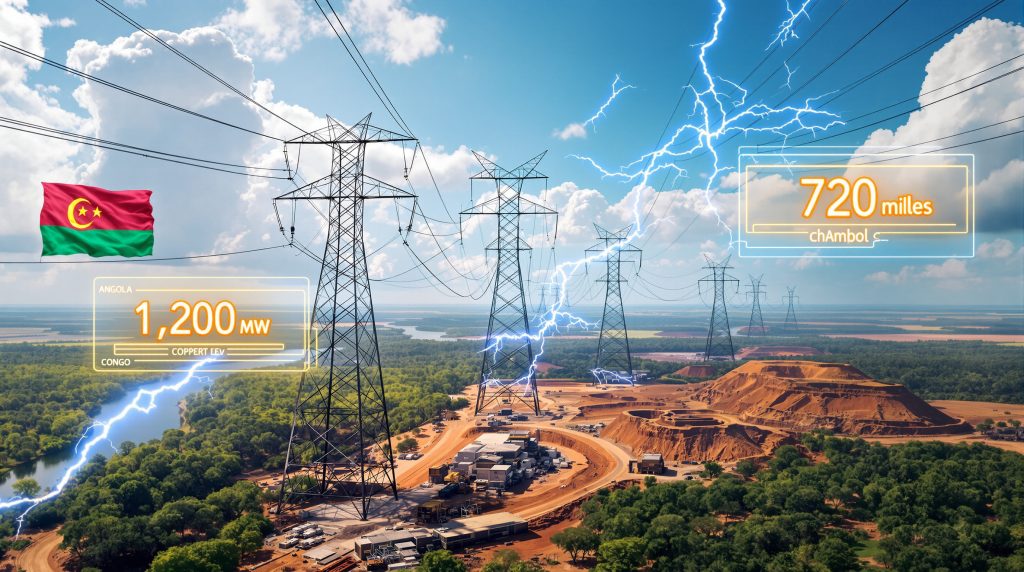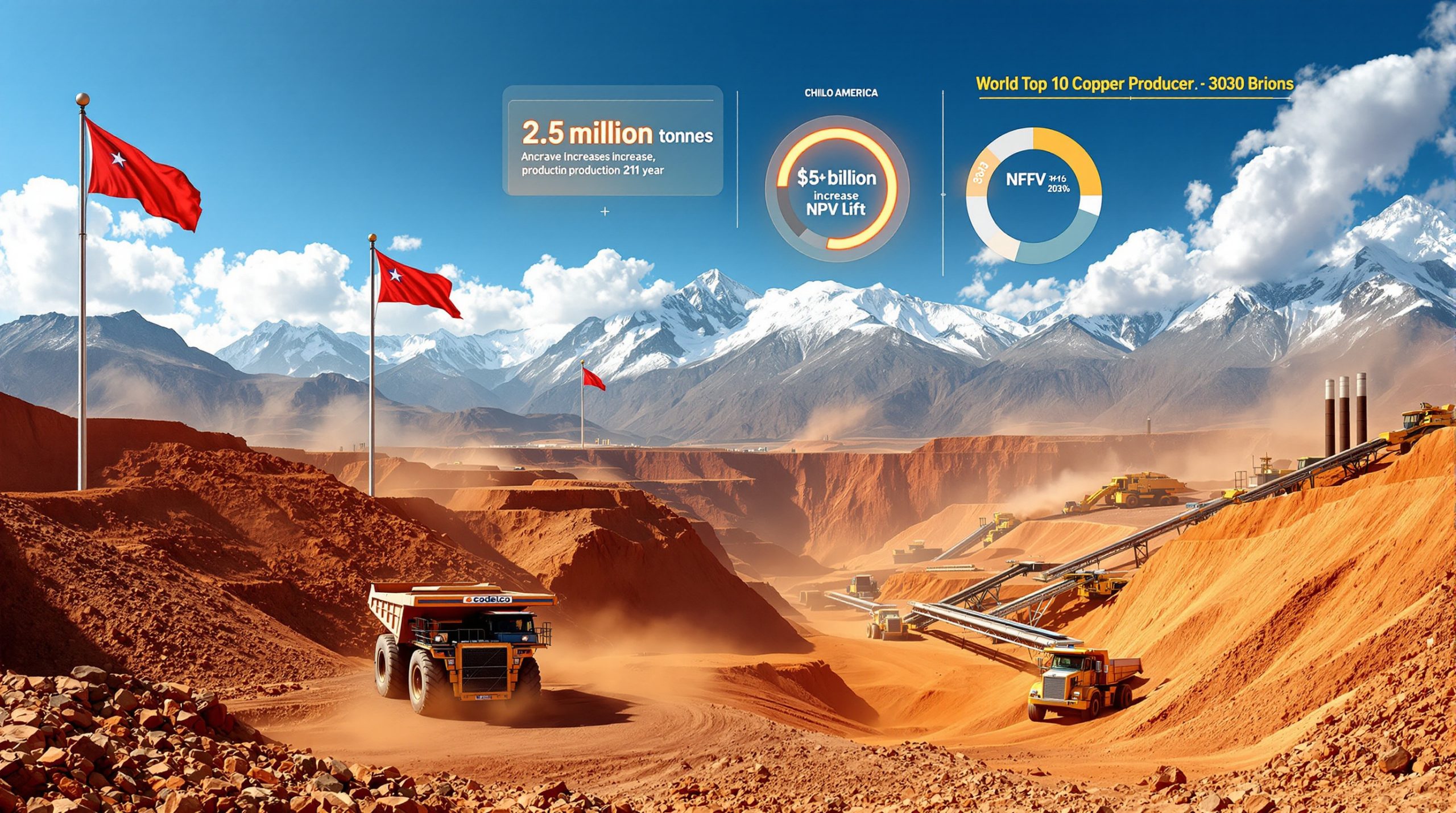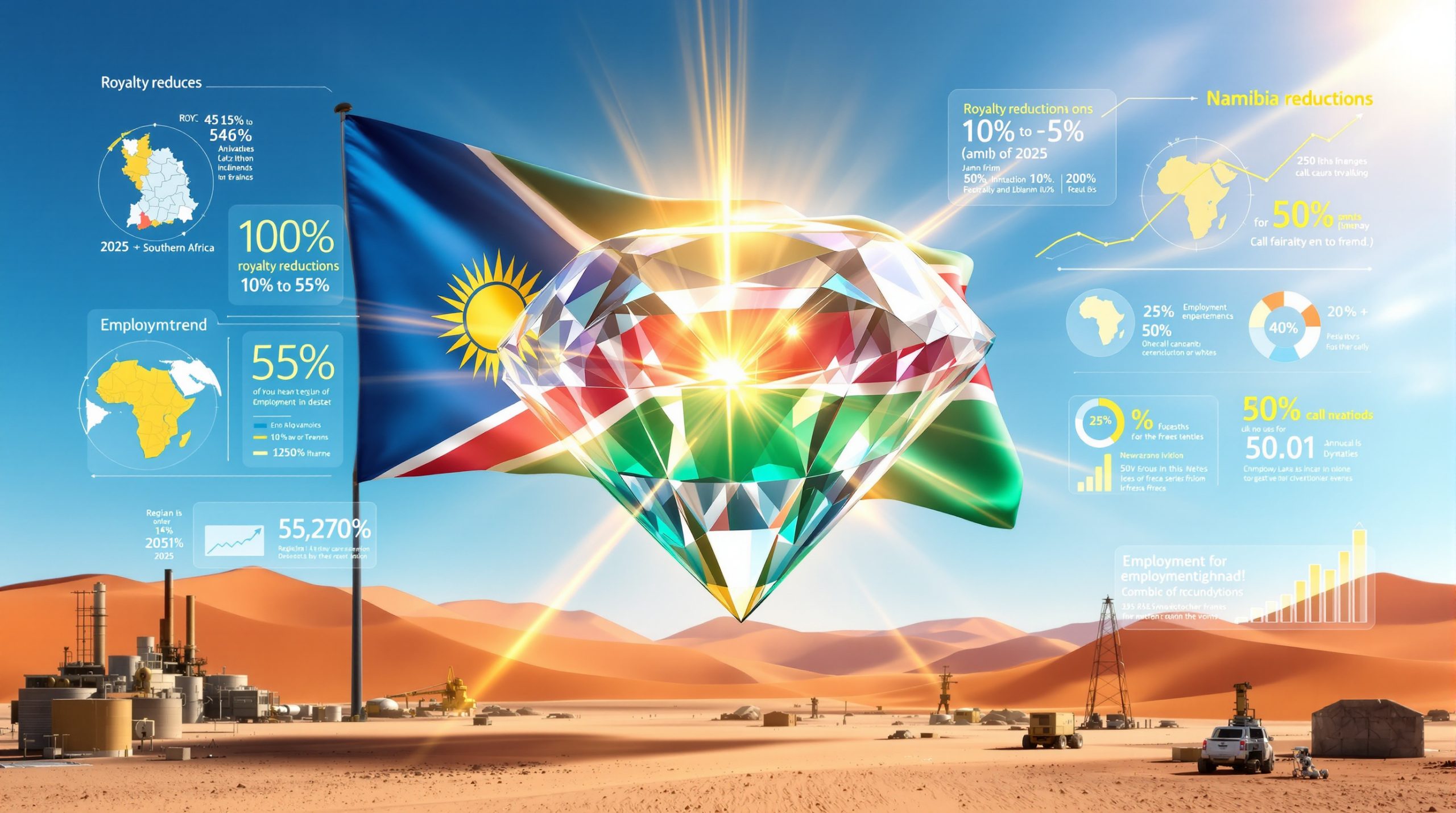The ambitious $1.5 billion cross-border electrical infrastructure project represents a watershed moment for Central Africa's mining sector. This transformative power line to Congo mines will deliver 1,200 megawatts of reliable electricity to operations that have long struggled with power shortages, fundamentally reshaping the region's mineral production landscape.
The transmission infrastructure will source power from Angola's Lauca hydroelectric complex, crossing international borders to reach Congo's mining heartland by 2029. With 70% debt financing secured through the US Development Finance Corporation and equipment contracts allocated to American manufacturers, the project aligns with strategic energy transition strategies while addressing critical infrastructure gaps in Central Africa.
Technical Infrastructure and Capacity Details
The engineering scope encompasses sophisticated high-voltage transmission technology designed for tropical conditions and cross-border operations. The system must traverse diverse terrain types while maintaining grid stability and synchronization between different national electrical frameworks.
Key technical specifications include:
- Transmission distance: 1,160 kilometres across international borders
- Power delivery capacity: 1,200 megawatts of baseload electricity
- Primary power source: Angola's Lauca hydroelectric plant system
- Grid synchronisation: Advanced systems for multi-national integration
- Climate adaptation: Tropical-resistant infrastructure design
The project addresses unique cross-border transmission challenges including regulatory harmonisation, grid code compatibility, and maintenance protocols spanning multiple jurisdictions. Engineering considerations for the tropical climate require specialised materials and design approaches to handle high humidity, lightning protection, and vegetation management along transmission corridors.
Mining Sector Power Crisis: Understanding the 1,500 Megawatt Deficit
Congo's mining operations currently face an electricity shortage exceeding 1,500 megawatts, according to the country's Mines Ministry. This substantial deficit forces mining companies to rely on expensive diesel generators, significantly increasing operational costs and environmental impact while limiting production capacity.
The power shortage stems from inadequate transmission infrastructure and limited grid connectivity rather than insufficient generation potential. Congo possesses some of Africa's largest hydroelectric resources through the Congo River system, yet the mining regions remain poorly connected to these power sources.
Impact on Mining Operations
The electricity deficit affects mining operations through multiple channels. Inconsistent power supply interrupts processing operations while diesel generation creates substantially higher electricity costs. Furthermore, carbon emissions from fossil fuel backup power impact environmental performance metrics.
Operational reliability remains compromised when mining companies depend on variable diesel supply systems. Power constraints restrict mine development projects and limit expansion possibilities across the region. Additionally, limited electricity access in surrounding communities hampers broader economic development initiatives.
Transforming Mining Through Reliable Power Infrastructure
The new transmission infrastructure will fundamentally reshape mining operations by providing consistent baseload power from clean hydroelectric sources. This transformation extends beyond simple cost reduction to enable entirely new operational approaches and expansion possibilities.
Mining companies operating in the affected regions will benefit from multiple operational improvements. Reliable grid electricity eliminates the need for expensive diesel backup systems while enabling 24/7 processing operations. The enhanced power reliability supports implementation of advanced mining technologies and automated systems that require consistent electricity supply.
Economic Impact on Mining Costs
The transition from diesel generation to grid electricity creates substantial cost advantages. Direct electricity cost reduction occurs through elimination of fuel transportation and storage requirements. Moreover, maintenance cost savings result from reduced reliance on generator equipment.
Operational efficiency gains through consistent power quality and availability provide additional benefits. Capital expenditure reduction becomes possible by eliminating need for backup generation investments. Processing operations particularly benefit from reliable electricity access, as mineral concentration, smelting, and refining processes require consistent power quality.
Environmental performance improvements represent another significant benefit. The shift from diesel generation to hydroelectric power substantially reduces operational carbon footprints while supporting sustainable mining certifications, aligning with broader renewable energy transformation initiatives.
Major Mining Companies Positioned for Transformation
Several international mining corporations operating in Congo's Kolwezi region will directly benefit from enhanced power infrastructure. These companies control some of the world's richest deposits of critical minerals essential for global energy transition and technological advancement.
Ivanhoe Mines Ltd. operates the Kamoa-Kakula copper complex, positioned to become one of the world's largest copper mining operations. The company's expansion phases depend heavily on reliable power supply, with multiple development stages requiring substantial electricity capacity for processing operations.
Glencore Plc maintains extensive cobalt and copper operations throughout the region. The company's Mutanda mine was placed on care and maintenance in 2019 partly due to operational challenges including power costs. Reliable grid electricity could enable reactivation of previously uneconomical operations.
Regional Mineral Resources and Strategic Importance
The Kolwezi mining district contains globally significant deposits of critical minerals. Copper reserves are essential for electrical infrastructure and renewable energy systems, while cobalt resources remain critical for electric vehicle battery production. Lithium deposits face growing demand from energy storage applications.
According to the U.S. Geological Survey, the Democratic Republic of Congo accounts for approximately 70% of global cobalt production and ranks among the world's top copper producers. The Lualaba Province, where Kolwezi is located, serves as the epicentre of this mineral wealth.
The International Energy Agency projects that cobalt demand could increase sixfold by 2040 under sustainable development scenarios. Similarly, copper demand from clean energy technologies could more than double by 2040, making copper investment insights particularly relevant for understanding market dynamics.
Cross-Border Power Transmission: Engineering and Regulatory Challenges
Building transmission infrastructure across international borders presents complex engineering and regulatory challenges that require sophisticated solutions and bilateral cooperation frameworks. The Angola-DRC project must navigate technical, political, and operational considerations spanning multiple jurisdictions.
Technical Engineering Requirements
Cross-border transmission systems require specialised design approaches. Grid synchronisation protocols ensure compatibility between national electrical systems while power quality management maintains voltage and frequency standards across borders. Protective relay systems coordinate fault protection between different grid operators.
Communication infrastructure enables real-time operational coordination, while emergency response procedures address cross-border incident management. Tropical climate conditions add additional complexity to transmission design, requiring high humidity resistance and specialised insulator designs.
Foundation engineering varies significantly across the 720-mile corridor, from Angola's coastal plains to Congo's interior highlands. Soil conditions, seismic considerations, and accessibility for construction equipment influence tower design and placement strategies throughout the transmission route.
Regulatory Framework Coordination
Cross-border energy projects require extensive regulatory coordination between participating nations. Bilateral agreements must establish clear protocols for operational control, maintenance responsibilities, and dispute resolution mechanisms.
"The success of international transmission projects depends on harmonised regulatory frameworks that address sovereignty concerns while enabling efficient energy trade," according to regional energy experts. Currency risks and payment settlement arrangements require careful structuring to protect both countries' interests while ensuring project viability.
Political risk considerations include potential changes in government policy, trade relationships, and international sanctions. The project's financing structure incorporates political risk insurance and diplomatic support to mitigate these concerns effectively.
Strategic Alignment with Global Energy Security Objectives
The Angola-DRC transmission project reflects broader geopolitical trends toward diversified critical mineral supply chains and strategic energy partnerships. This alignment becomes particularly relevant considering the US critical minerals policy framework identifying 50 mineral commodities as critical to economic and national security.
American involvement in the project extends beyond financial support to encompass strategic supply chain objectives. The US Development Finance Corporation's participation signals government commitment to securing critical mineral access through infrastructure development rather than direct resource acquisition.
America First Policy Integration
The project structure deliberately incorporates domestic American economic benefits. Equipment manufacturing allocates over 30% of project costs to US-based suppliers, while engineering services are provided by American firms including Sargent & Lundy.
Financial institutions including the US Export-Import Bank provide export credit facilities. Technology transfer supports American transmission equipment manufacturers, reflecting evolving strategies for critical mineral security that emphasise infrastructure development and partnership approaches.
This approach demonstrates innovative development finance methods that enable increased production from existing operations rather than developing new mining projects. Consequently, the transmission infrastructure supports supply chain diversification with reduced environmental and social risks.
Regional Power Integration: Supporting Projects and Initiatives
The Angola-DRC transmission line represents part of broader regional energy integration efforts across Central and Southern Africa. Multiple power pool initiatives and cross-border interconnection projects aim to optimise energy resources and enhance supply security across national boundaries.
The Central African Power Pool and Southern African Power Pool provide frameworks for regional energy cooperation and trade. Congo's membership in both organisations creates opportunities for multi-directional energy flows and enhanced grid stability through diversified supply sources.
Complementary Infrastructure Developments
Several additional transmission projects support regional mining sector development. Zambia-DRC interconnection projects explore enhanced power trading between neighbouring countries with complementary energy resources and mining industries.
Regional integration through power pools facilitates electricity trading among member countries, including emergency power supply arrangements and coordinated maintenance scheduling. Infrastructure standardisation efforts promote harmonised technical standards for cross-border transmission, reducing costs and complexity for international power projects.
Energy security through diversification enhances reliability for mining operations. The interconnected regional grid enables mutual support during emergencies or maintenance outages, while different regions experience varying weather patterns and hydrological conditions.
Long-Term Mining Sector Transformation and Market Implications
Reliable power infrastructure will catalyse fundamental changes in Congo's mining sector, extending far beyond immediate operational improvements. Enhanced electricity access enables entirely new business models, processing capabilities, and value addition opportunities that could reshape the country's position in global mineral markets.
Processing Capacity Development Potential
Consistent power supply enables development of downstream processing facilities that add value before export. Rather than shipping raw copper and cobalt concentrates, mining companies can consider copper smelting and refining operations producing finished metal products.
The Democratic Republic of Congo government has expressed strong interest in developing local processing capacity rather than exporting raw materials. However, such facilities require reliable electricity supply for continuous high-temperature operations and quality control systems.
Investment Climate Enhancement
Improved infrastructure fundamentally alters risk profiles for mining investments in the region. Power supply reliability eliminates a major operational risk factor that previously discouraged international investment or required expensive mitigation measures.
Enhanced project viability means previously marginal deposits become economically viable with lower operational costs. Technology adoption opportunities arise from reliable electricity enabling deployment of advanced mining technologies including automated equipment and digital mine management platforms.
Environmental performance improvements support mining companies' environmental, social, and governance commitments while reducing carbon footprints. This development aligns with the broader mining industry evolution towards sustainable practices and enhanced investor requirements.
Global Mineral Market Impact
Enhanced production capacity in Congo's mining regions will influence global commodity markets through increased supply availability and improved cost competitiveness. The Democratic Republic of Congo's position as a major supplier of critical minerals means that operational improvements create global market effects.
Supply chain reliability improves through enhanced operational stability, reducing supply chain risks for manufacturers dependent on Congolese minerals. Cost structure changes improve the competitiveness of Congolese mineral production versus other global sources, potentially influencing global pricing dynamics.
Processing location decisions may shift some mineral processing activities from traditional consuming countries back to producing regions. Market psychology and investment sentiment benefit from successful completion of major infrastructure projects, demonstrating the country's capacity for large-scale development and international cooperation.
The completion timeline for this groundbreaking power line to Congo mines remains set for 2029, when the full 1,200 megawatts of transmission capacity will become operational. This infrastructure milestone will mark a new era for Central African mining operations, establishing the foundation for sustainable mineral production and economic development across the region.
According to recent analyses, the US firm has inked a pact to build this $1.5 billion power line to Congo mines, while additional reporting confirms that the Angola-DRC power line will be commissioned in 2025 according to energy sector sources.
This analysis is based on publicly available information and industry reports. Investment decisions should consider multiple factors including political risks, regulatory changes, and market conditions. The projected timelines and benefits discussed represent potential outcomes that may vary based on implementation success and market developments.
Ready to Capitalise on African Mining Infrastructure Developments?
Discovery Alert's proprietary Discovery IQ model delivers instant notifications when significant mineral discoveries are announced on the ASX, helping you identify the next major mining opportunity before the broader market. Begin your 30-day free trial today and discover why successful investors rely on real-time discovery alerts to maintain their competitive advantage in the dynamic mining sector.




